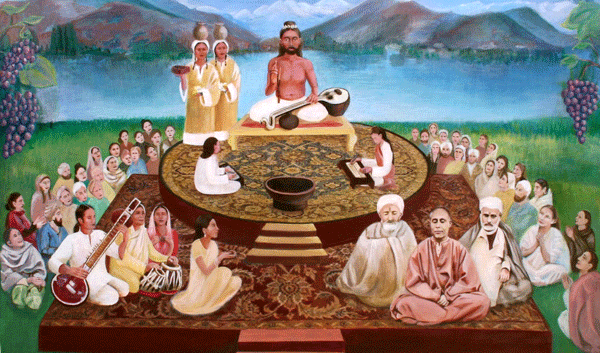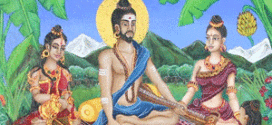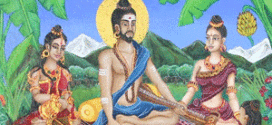Life Achivments Work Media Publication
Life of Abhinav Gupta
Most of the information about the life of Abhinavagupta is gleaned from his own writings. Abhinavagupta was a Brahmin whose ancestors had been distinguished scholars in the court of Kanauj. His ancestor Atrigupta, who was born in Antarvedi, the Doab between the Ganges and the Jamuna, was serving the king of Kanauj Yasosvarman, who was defeated by King Lalitaditya (c. 725 – 761). King Lalitaditya brought Atrigupta to Kashmir along with the booty, and, “in that beautiful city (Srinagar) like that of Kubera’s (Alka) in front of the temple of “Sheetanshumauli” (Siva having the moon as his crest) on the Vitasta, the king got built for him a spacious house and also granted a Jagir of land to him.” Abhinavagupta’s grandfather was Varagupta and his father Naramsimhagupta, also known as Cukhala. Abhinavagupa was born in Kashmir around 940 – 950 C.E.. His beloved mother, Abhinavagupta, Vimalakala, died when he was still a child. In Kashmir it is traditionally believed that Abhinava was a Yoginibhu (born of a Yogini). His family had a long tradition of scholarship and his parents were sincere devotees of Lord Shiva. About his family, Abhinava says, “All the members of the family regarded material wealth as a straw and they set their hearts on the contemplation of Shiva.” His uncle Vamana Gupta was an expert in poetics. His father, Narasimha Gupta, taught him Sanskrit grammar, logic and literature. It is said that in his youth, Abhinavagupta learned easily and readily comprehended even difficult philosophical concepts, and his speech was measured and elegant.
Abhinavagupta’s principal teacher was Lakshmana Gupta, but he traveled widely, even outside of Kashmir, to study different Shastras (teachings) under different at least 19 different teachers, including Buddhist and Jaina masters. In his Tantraloka (V11, 205, 206) he says that even though one might be lucky enough to get a teacher who has attained perfection himself and can easily lead his pupil to it, that does not mean one should not approach other teachers for obtaining knowledge of other teachings and other paths. He successively practiced and contributed to the development of each of Kashmir Shaivism’s three great schools, Krama, Trika, and Kula. Abhinavagupta credited the teacher Shâmbhu Nâtha in Jâlandhara, from whom he received the practices of the Kaula tradition, with leading him to enlightenment and true peace.
Later writers refer to Abinavagupta as ‘Abhinavaguptapada.’ The word “pada” is an honorific, but in this case implies another meaning, because “guptapada” means “serpent” (Shesa). ‘Abhinavaguptapada’ would thus mean ‘a new incarnation of Shesha.’ Shesa, the serpent God, was one of the manifestations of Vishnu. Vamana the propounder of Riti school in Indian Rhetorics and commentator of ‘Kavya Prakasha’ known as “Bala Bodhini” bas Pandit Vamanacharya Jhalikikar, propounder of Riti school in Indian Rhetorics and commentator of ‘Kavya Prakasha’ known as “Bala Bodhini” alluded to Abhinavagupta as ‘an intellectual giant and like a serpent (terror) to his young school fellows.” His teachers, who were impressed by his intelligence and keen memory, called him Abhinavaguptapada. Abhinava himself says in Tantraloka (1.50)(Light of the Tantras), “This is the work written by Abhinavagupta, who was so named by his Gurus (elders, teachers).”
Later in his life, Abhinavagupta rose to the position of Acharya [Master] of the Shaiva sects in Kashmir. When Abhinavagupta wrote Tantaloka (The Light of the Tantras) in his early middle age, he seems to have had just a small group of close disciples, almost all of whom were members of his family. He tells us that his brother Manoratha was one of the first to learn from him and that he was later joined by Karna, the husband of his sister Amba. When Karna died prematurely and left Amba alone with their only son, she devoted herself entirely to the worship of Lord Shiva and the service of her brother. Karna’s father, a minister who had left the court to become “a minister of the Lord;” her father’s sister, Vatsalika; and Mandra, Karna’s cousin and close friend, were all devoted to him and served him faithfully. Mandra invited Abhinavagupta to stay in his town outside Pravapura (modern Srinagar) where, in the house of Vatsalika, he wrote his Tantaloka for the benefit of his disciples, who Abhinavagupta tells us at the end of his work, wanted to gain “a perfect knowledge of the Tantras.” Almost all the other disciples he refers to were sons of his paternal uncle, Utpala, Abhinava, Chakraka and Padamgupta and one named ‘Kshema,’ who might have been Kshemaraja, his most distinguished disciple.
“There are dull-witted people who are confused themselves and throw the multitude of creatures into confusion. Having bound them fast with fetters, they bring them under subjection with tall talk of their qualities. Having thus seen creatures who are simply carriers of the burden of gurus and their blind followers, I have prepared a trident of wisdom in order to cut asunder their bondage.”
The date of Abhinavagupta’s death is estimated at around 1025 C.E.. According to Kashmiri tradition, he entered a cave while reciting the Bhairavastava along with 1,200 disciples, and was never seen again. This cave, alleged to be his burial place, is located at “Birwa” village some five miles from Magam on the Gulmarg range.
For more details Visit the more links….
1 2 3 4 5
 पौराणिक कथाओं, प्रेरक क्षण, मंदिरों, धर्मों, फिल्मों, हस्तियों के बारे में दिलचस्प जानकारी, हजारों गाने, भजन, आरती के बोल हैं Your wish may come true today…
पौराणिक कथाओं, प्रेरक क्षण, मंदिरों, धर्मों, फिल्मों, हस्तियों के बारे में दिलचस्प जानकारी, हजारों गाने, भजन, आरती के बोल हैं Your wish may come true today…


























